Note: This is part 3 of a 3 part series on Morocco.
“A little imagination goes a long way in Fes.”
-Tahir Shah
In my last blog post, I told the story of my 4 day journey through the Sahara Desert from Marrakech, Morocco, to the city of Fes. Fes (or Fez) is a city of over 1.1 million people located in north central Morocco, northwest of the Atlas mountains. Fes is one of the four imperial cities of Morocco and is considered to be the spiritual and cultural capital of Morocco. Fes was founded around the turn of the 9th century CE. In the centuries to come, successive waves of Arab immigrants came to Fes and gave the city its Arab character. In the 11th century, the Almoravid dynasty merged what had been two separate settlements into what is now the historic medina of Fes, known as Fes el-Bali (Old Fes). By the 13th century, Fes had established a reputation as a center for religious scholarship and for the next two centuries it served as the political capital of Morocco. New religious schools (madrasas or mederasas) and mosques were built and older buildings were restored. The city was growing and a new district called Fes Jdid (New Fes) was built. This includes the Royal Palace which is still there today and the Mellah (Jewish Quarter).
After the fall of the Maranid dynasty, Fes lost its status as the+ capital of Morocco, only to regain it from the 1700s all the way until 1912. During the French colonial era, the much larger Ville Nouvelle (New City) area of Fes was built. Today Fes is renowned for its spectacular architecture and cultural heritage. Fes el-Bali is a UNESCO World Heritage Site and one of the world’s oldest and largest car-free zones. Fes has sometimes been called the “Mecca of the West” and the “Athens of Africa”, both somewhat dubious comparisons that remind me of when people call Costa Rica the “Switzerland of Central America”. Fes deserves to be understood and appreciated on its own terms, and I hope this blog post will help you to do just that.
When my tour van dropped me off at my riad after a 9 or 10 hour journey from Merzouga in the Sahara, it was evening. I checked in, drank my obligatory mint tea, and settled into my comfortable second-story room. The riad was just as gorgeous as the one in Marrakesh but distinct in its design. Unlike the other riad, the roof covered its central courtyard. Where the Marrakech riad had lavish and extravagant decoration, the one in Fes was slightly more subdued but also perhaps more sophisticated. I see this as an apt metaphor for the cultural differences between Marrakech and Fes. Marrakech is a very “in your face” city–a riot of sounds, smells, and colors. Fes is still a busy thriving city, but it has a somewhat calmer, quieter vibe. Both cities are amazing, and neither are perfect, but they complement each other’s differences very well.




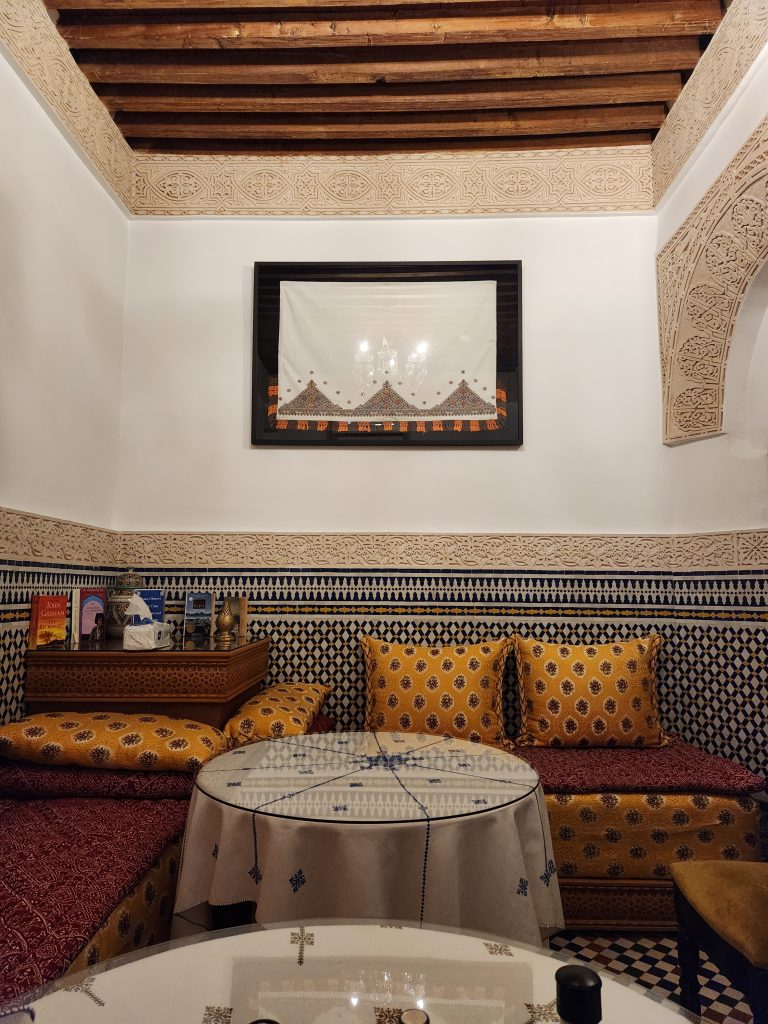

I woke up refreshed the next morning and enjoyed a tasty breakfast of Moroccan pancakes and bread with various spreads, oranges, yogurt, juice, and coffee. While the portions were more manageable than the supersized meals they fed me in Merzouga, it was still a lot of food.
My riad was located on a quiet street on the edge of the Fes el-Bali medina, and after stopping at an ATM to pull out some money, it was a short walk to Bab Bou Jeloud, the famous blue gate built in 1913 during the colonial period. Next to this flashy gate is a much older, much simpler archway that may date back to the 12th century.


THE OLD MEDINA
I walked through the Blue Gate into the labyrinth of old streets, alleyways, plazas, and corridors that is the medina. The medina was crowded and chaotic, but with a little more breathing room than the one in Marrakech. I love the Marrakech medina but when you’re in the middle of it, it can feel like being in the Times Square subway station during rush hour (or perhaps more like those Tokyo subways where they employ professional shovers to pack as many people as humanly possible into a tiny space). It can be overwhelming. The Fes medina would probably feel that way too to anyone who has never been to a medina or similar type of environment, but I felt less jostled there than in Marrakesh, and that was a good feeling. In addition to the gauntlet of shops, restaurants, and outdoor and indoor marketplaces, there are numerous elaborately decorated shrines, fountains, arches and doors peeking out from every nook and cranny.
The first landmark I saw in the medina was the water clock. Dar al-Magana (The House of the Clock), sometimes referred to as the House of Maimonides after the Jewish philosopher who is rumored to have lived there, is a 14th century building that features a hydraulic clock. The clock is made of 12 windows and platforms holding brass bowls. The clock was kept in motion by a small cart that ran back and forth between twelve doors. The cart was attached to a hanging weight on one side and on the other side to a weight that floated on the surface of a water reservoir that was drained at regular intervals. Each hour the doors opened and a metal ball dropped into one of the twelve bowls to mark the time. It was a complicated mechanism that would put Rube Goldberg to shame. Unfortunately, the clock no longer functions, but there are some organizations that have raised the possibility of restoring it in the future.



The water clock is part of the complex of structures that makes up the Bou Inania Madrasa, one of several breathtaking historic madrasas (Muslim religious schools/colleges) in Fes. Completed in 1355 and located between two of the most important streets in the medina, Bou Inania is highly regarded as one of the best examples of classic Moroccan architecture. The adjoining mosque, which can be seen from the Blue Gate, was the only public congregational mosque in Morocco attached to a madrasa. The main building includes study areas, living quarters for students, an internal mosque or prayer hall, and a room for ablutions. Other side buildings are located across the street. The madrasa is elegantly decorated with intricate stucco work and wood.


Next, I visited another Madrasa–El Attarine. Built in the 1320s and located near a spice and perfume market (souk), El Attarine Madrasa is another fabulous example of Moroccan architecture. Although it shares many of the same design elements as Bou Inania, it stands out for its colorful geometric designs. You can also visit the rooftop of the madrasa, which has a great view of the medina and beyond. Like the other madrasa, it contains student living quarters and all the other structures that a religious school required. In fact, the madrasa even provided free food and housing to poor out-of-town students attending the nearby al-Qarawiyyin University and Mosque.
I wanted to visit al-Qarawiyyin University itself, and although I knew I wouldn’t be allowed to enter the mosque, I had read that the university library was open to the public, including non-Muslims. However, When I was there it seemed to be closed and people were hanging up lines of string on the streets to indicate places were non-Muslims shouldn’t go (some sort of time-specific religious observance that I didn’t really understand). So I had to content myself to enjoy glimpses of it from the outside. Al-Qarawiyyin University was founded in 857 and for centuries was regarded as the highest seat of learning and religious scholarship, not only in Fes but in all of Morocco and the entire Maghreb region of North Africa. According to UNESCO and the Guinness Book of World Records, al-Qarawiyyin is the oldest continuously operating university in the world. Scholars have come to study or lecture here from all over the Muslim world. It is still a functioning university and its academic programs were reformed and modernized in 1963. Its courses still focus heavily on religious studies, Arabic language, and law, but the curriculum has been expanded to include a robust education on a variety of other subjects.
Another place in this area that I only viewed from a distance was the Zawiya (mausoleum) of Moulay Idris II. Moulay Idris II was the ruler of Morocco from 807 to 828 and is considered the founder of the city of Fes. His tomb is one of the holiest shrines in Morocco. A tall minaret decorated with a green geometric pattern towers over the Zawiya and dominates the skyline (such as it were) of this part of the medina.









While walking around this general area, I also popped into a small palace that has been turned into a restaurant and a historic bathhouse that I bought a ticket to see, thinking that it was only a historic site and then having a hard time trying to explain to the older gentleman on duty that I didn’t need a towel or a locker and that I would in fact be leaving now.









Another highlight was Place Seffarine, which is flanked by workshops where you can watch master craftspeople make beautiful objects out of metal, wood, and other materials. I bought a small hand-made decorative copper plate here and a resident smith explained to me how it was made and how you can distinguish its quality from the mass produced kind you can find elsewhere in the medina. I wish I had space in my luggage to buy more of the high quality handmade products for sale in these squares. If you visit Fes, I highly recommend visiting Place Seffarine and the woodwork market in Najjerine Square before buying a lot of souvenirs elsewhere because it will show you the range of quality available here. I hear there is also a large fine crafts market in Ville Nouvelle, so if you’re spending time in the modern part of Fes, check that out as well.

I stopped for lunch at a hip place called Cafe Clock. I ordered the Fes platter, which included salad, something similar to baba ghanoush, sweet potato fries, chili aioli, falafel, and little slices of grilled bread. I washed it down with a spiced coffee.
GARDENS AND TOMBS
After lunch, I left the medina to visit some other parts of historic Fes. I have read that this area has some incredible museums like Dar Batha and Borj Nord, but they were all closed for renovations. I learned later that they have been waiting for renovations for many years now, and that the pandemic set the progress of these renovations back even further. It is unknown when they will re-open at this point.
Nestled between the Fes el-Bali medina and the newer medina of Fes Jdid is the Jnan Sbil Gardens. This expansive urban oasis was originally built in the 1800s as a private retreat for the sultan and his royal court and was connected to the Royal Palace by an underground passage. Today the gardens are open to the public and are a popular place to relax. The gardens are decorated with fountains and sculpted shrubbery and are home to over 3,000 species of plants. The gardens are located on the banks of the Fes River (Oued Fes) and some historic water wheels that used to channel water to the old city can still be seen on the premises. There was also a “Christmas tree” on display in the garden, which did not look like anything most Americans would recognize as a Christmas tree but it was a tree decorated with balloons and garland and a sign declared that it was indeed a Christmas tree.
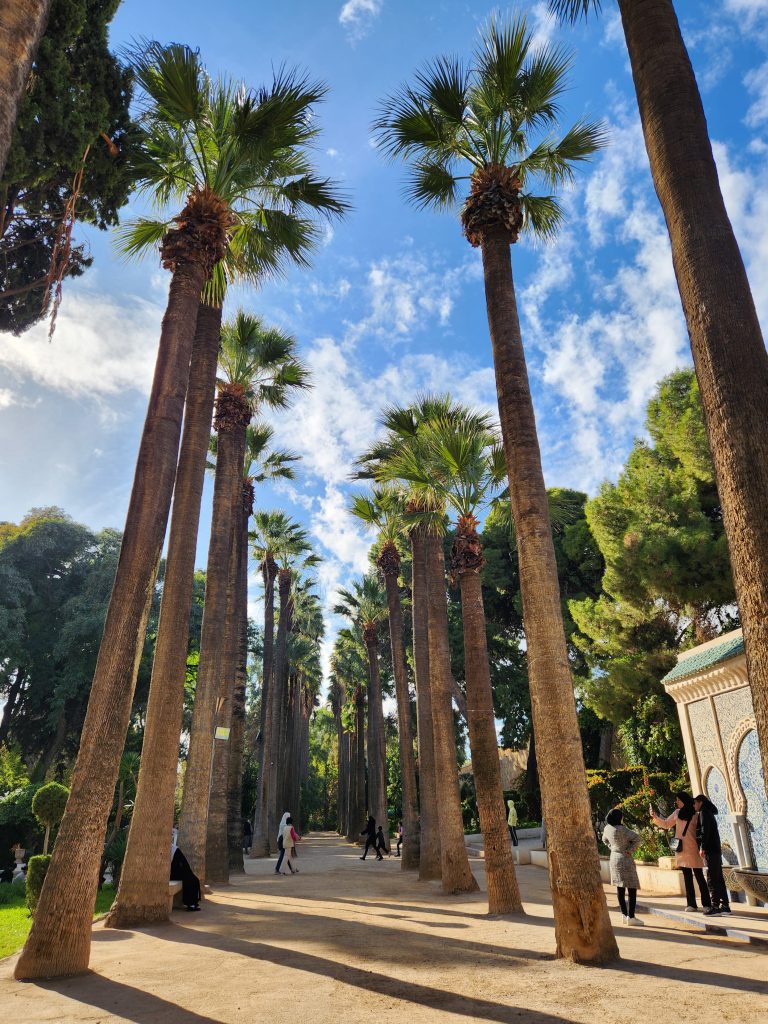










After resting in the gardens, I took a long walk along the fortified yellow adobe walls that guard the outer border of the old city. As I gradually ascended into the hills on the northern edge of Fes, I enjoyed a panoramic overlook of the city. Passing by the closed Museum of Arms, I eventually reached the Maranid Tombs that overlook the city. These large brick monuments were part of a necropolis used to bury the royal family of the Maranid dynasty in the 1300s. The tombs are barren ruins now but they are still an impressive site high up on a hill above Fes el-Bali. There used to be a palace here as well but after it was abandoned it was gradually picked apart for quarrying over the centuries and little evidence of its existence remains today.













As the sun started to get low in the sky, I caught a cab to Cafe Cinema (which is a movie-themed restaurant, not a cinema) a few blocks away from my riad. I had a very good dinner of harira soup, falafel, hummus, toasted pita bread, and mint tea. I spent the rest of the evening at my riad.
THE JEWISH QUARTER
The next day was New Year’s Eve and my last full day in Morocco. Breakfast was the same as the day before but with bananas instead of oranges.
On that morning I visited the “new” medina of El-Jdid, not to be confused with the modern part of the city, Ville Nouvelle. The residential part of El-Jdid was very quiet on this morning, with few if any tourists. Eventually I made my way to the Royal Palace, at the center of the royal citadel that was originally built in the 1200s and then greatly expanded over subsequent centuries. Although the palace itself is closed to the public, its main gate, the Dar al Makhzen, is richly decorated and there is a large plaza in front of it lined with palm trees. I walked here from my riad in the old medina but there didn’t seem to be many visitors travelling on foot here. However, a large tour bus did pull up to the palace right around the same time as me and a lot of tourists got out to take pictures.
After seeing the palace, I walked down toward the river, passing by a children’s soccer game in progress before reaching the Aben Danan Synagogue, located in Fes’ historic Mellah or Jewish Quarter. This synagogue was built in the 17th century and was in use as an active congregation until the 1960s. It’s a modest yet elegant building with some elements of traditional Moroccan architecture like colorful stucco work. As an orthodox synagogue, men and women would have been separated during services and there is a balcony for the women. I was able to visit the synagogue’s underground cellar, which still contains a mikveh or ritual bath.
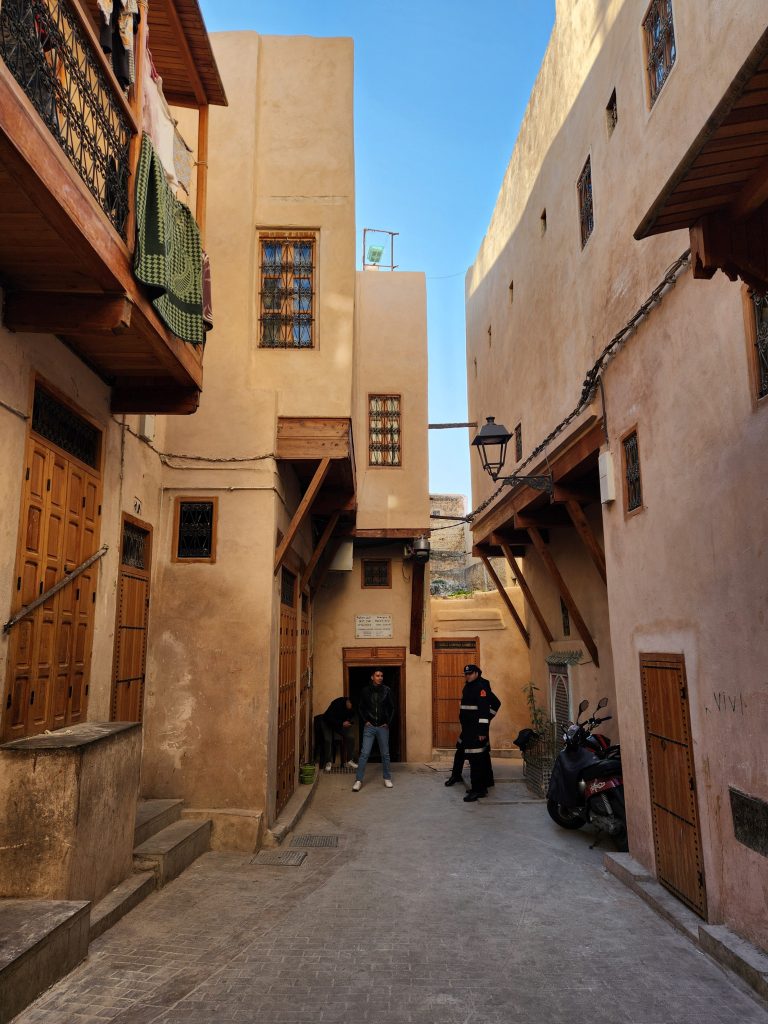


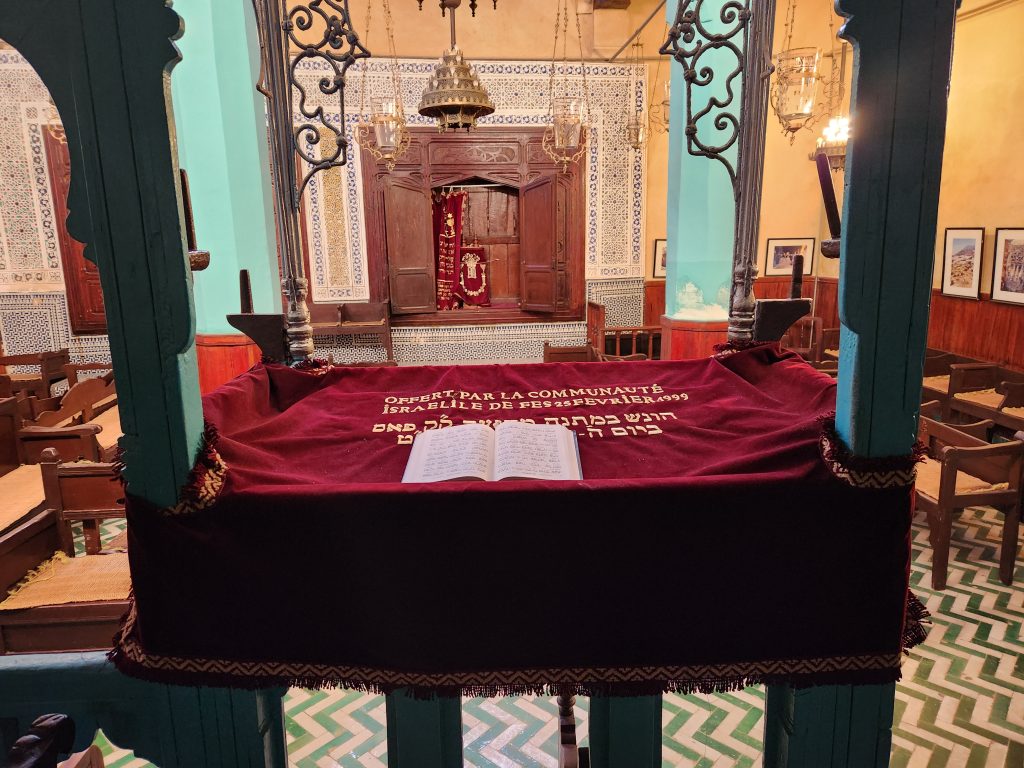
Although there are less than 150 Jews left in all of Fes today (but more than one, as a Jewish shopkeeper I met in the medina would have you believe), the Mellah still contains unique Jewish characteristics. One of the most noticeable is the balconies. While Muslim Moroccans who can afford to have traditionally had inward-facing balconies around a central riad courtyard, Jewish Moroccans had a tradition of building outward-facing balconies overlooking the street. Although most of these houses are no longer occupied by Jewish families, the balconies remain in this neighborhood, unlike the rest of Fes. At the edge of the Mellah is a Jewish cemetery where countless generations of Moroccan Jews are buried. I didn’t enter the cemetery but I saw it from a distance. I also saw the newly established Jewish Culture Museum but unfortunately it was closed when I was there. According to an article on the website of the European Jewish Congress, the 13,000 foot museum “aims to preserve the architectural character of the ancient city of Fez and to take care of its cultural and spiritual heritage, including the Jewish heritage as a component of Moroccan identity”.





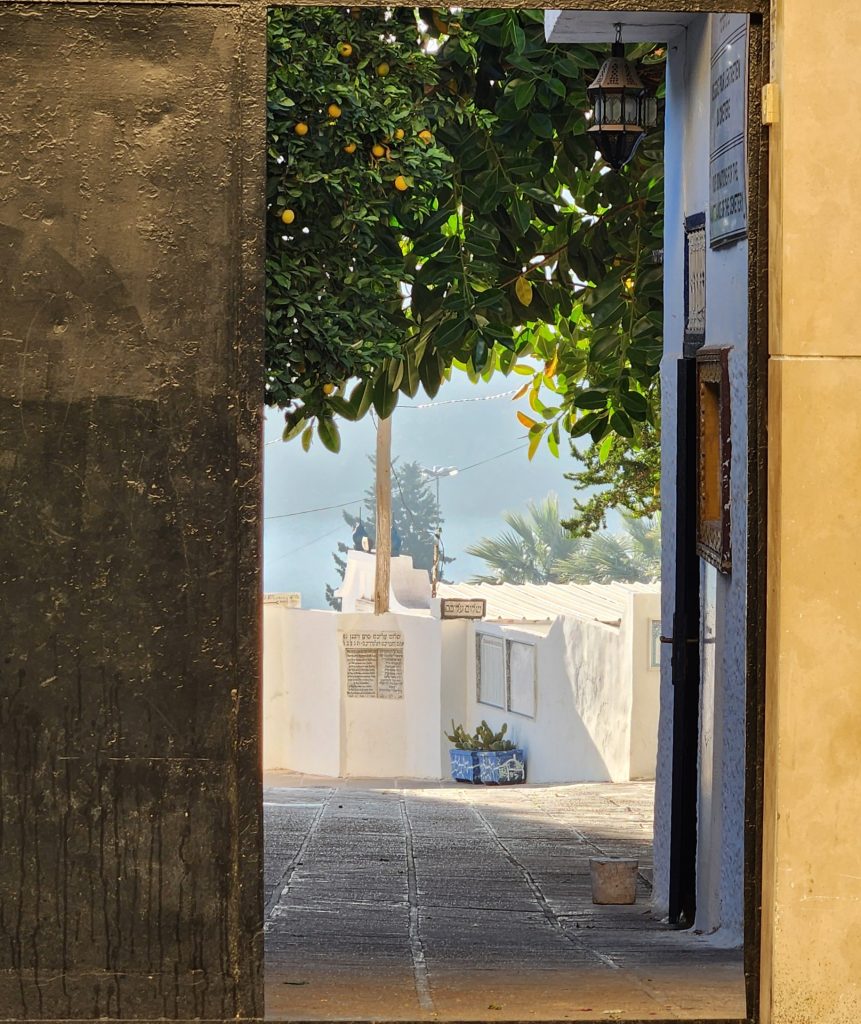


My last stop in the Mellah was the Semmarin medina gate. One of the more famous of Fes’ many gates, this handsome 13th century arch marks the traditional entrance to the Mellah. It features an Andalusian design and a vaulted ceiling.

After my visit to the Mellah, I returned to Fes el-Bali (the old medina) and ate lunch at a popular food stand called Broceilande that serves delicious vegetarian soup at rock bottom prices. It’s within striking distance of at least two other vegetarian restaurants (Culture Box and Veggie Break) but unlike those two places, the clientele of Broceilande is mostly locals, which was reflected in the prices. In fact the price of a large bowl of bissara soup (a delicious traditional Moroccan soup made with olive oil), a loaf of freshly baked bread and a glass of mint tea was so low that I was confused about the price at first. The conversion rate is simple–10 Moroccan Dirham equals 1 US dollar–but I couldn’t wrap my mind around the fact that this tasty and filling meal cost only 70 cents, not $7.00. I ended up giving a tip that was more than the price of the food. I now understood just how inflated the prices were at some of the other places I had been eating, which were still cheap by American standards.
IT’S ALL WOOD IN THIS NEIGHBORHOOD
Next, I visited the Nejjarine woodworking museum, located in Nejjarine Square, an outdoor souk renowned for its master carpenters and its beautiful fountain. This museum is devoted to the history of woodworking in Morocco and there are three stories of incredible art, tools, and other artifacts spanning centuries of Moroccan history. From indoor treasures like ornamental chests, musical instruments, and ceremonial wedding chairs to arches and doorways from historic mosques and palaces, along with antique woodworking tools and even examples of the different types of trees found in Morocco, there is a lot of fantastic stuff here. You can also go on the rooftop here and see a great view of the medina.
At this point I was pretty much done with my Fes itinerary and I wandered aimlessly though the medina for a while. I had thought about visiting the archeological sites in the historic imperial city of Meknes, which is less than an hour away from Fes by train or bus, but at this point it was getting too late in the afternoon to be worth it to do that. If I had one more day in Fes, I would have spent it visiting Meknes and the adjacent Roman ruins of Volubilis. I also would have liked to spend some time in Ville Nouvelle, having only really seen it from the tour van on the way here from the desert. Fes is also home to one of the oldest leather tanneries in the world and it’s located very close to Nejjarine square, but as a vegetarian the sight and smell of leather tanning doesn’t really appeal to me.
After a leisurely stroll in the medina, I returned to my riad to relax and start packing for my return home. I ate a homemade meal in the riad that day and it was glorious. Although I had gotten sick of tagine during my time in the desert, I had had a break from it for a couple days and they served me a vegetarian tagine that was literally still boiling in the pot when they set it on my table. Along with the tagine came harira soup, fresh bread, olives, a spicy condiment, mint tea, and one of the most delicious and unique things I’ve ever tasted, a mildly sweet chewy pastry topped with sesame seeds called chebakia that was supposed to go with the soup to balance out the acidic flavor but which was also delicious on its own. I bought a box of pastries that included chebakia in the Casablanca airport the next day, but it was nowhere near as good as this homemade version. For desert, I was served a plate of hot flan. This meal was a fantastic way to say goodbye to Morocco.

NOTHING CHANGES ON NEW YEAR’S DAY
Even though it was New Year’s Eve, there were no fireworks or anything like that. Most Moroccans celebrate Muslim New Year, which is in July, and there is also an Amazigh (Berber) New Year that falls on January 12th, so December 31st and January 1st are not big holidays here. And the main way that New Year’s Eve is celebrated in the West–with copious amounts of alcohol–is frowned upon here. Alcohol is not illegal in Morocco but it goes against the religious beliefs of many Moroccans. In fact, I’ve heard of Moroccan waiters at international hotels and restaurants who will not even touch a bottle of alcohol to open it, instead finding a non-Muslim staff member to do it. If you choose to drink in Morocco, please do it discreetly–out of respect, and also because it is illegal to drink in public areas, as some Western tourists posing in the Sahara desert with cans of Sahara beer have found out the hard way. For my part, I didn’t drink during my time in Morocco, since I can do that anytime at home and there are plenty of better ways to spend one’s time here. Besides, “Moroccan whiskey” (mint tea) tastes much better than any alcoholic beverage I’ve ever had. I did see a poster on a luxury hotel near my riad advertising a New Year’s Eve party but it cost $75 (more than 100 times the price of my lunch that day) and was clearly designed for rich international visitors. I’d be surprised if any Moroccans attended that party other than the ones who were being paid to work there. I rang in the New Year quietly in my riad and then went to sleep.

On New Year’s Day 2024 I got up early, checked out of my riad, and had them call me a taxi to take me to the train station. I purchased tickets for a train to Casablanca, where I would fly home from. I had planned to buy a second class ticket, but the first class tickets cost only slightly more, so when they asked me if I wanted to upgrade, I figured why not. The first class train compartment was very comfortable. The trains in Morocco may not be quite as sleek and new as the ones in Switzerland or as fast as the bullet trains in Japan, but they were still very nice and more up to date than most trains in the U.S. The train passed through the capital city of Rabat, and the former pirate enclave of Sale before arriving in Casablanca. From here, I had to transfer to a different train that would take me directly to the airport. The short time I waited on an outdoor train platform for the airport shuttle was enough to make me break out into a sweat. I couldn’t believe how much hotter and more humid it was here, less than 300 miles from Fes. I could literally smell the humidity wafting in from the Atlantic Ocean. If it’s like that in January, I can’t imagine being here in the summer.



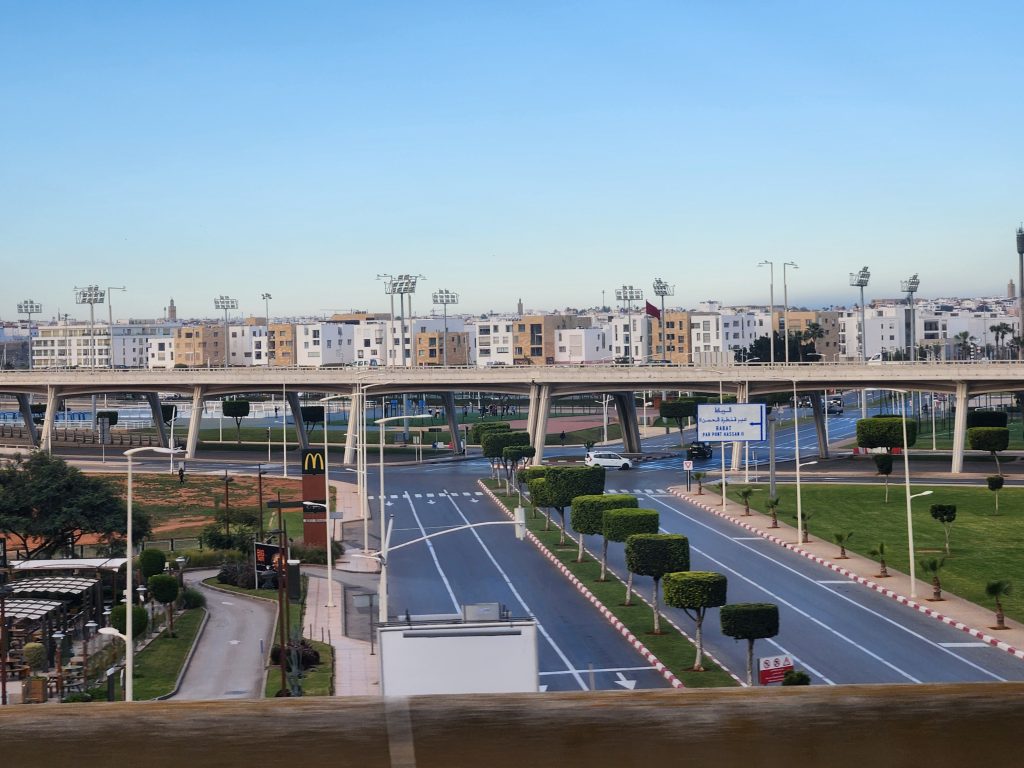
I arrived at the airport, ate a veggie pizza at one of those generic types of restaurants that only exist in liminal spaces like airports, and caught my flight without any issues. The flight home was uneventful, although when I got to my car, parked in the airport economy parking lot, I was dismayed to find that the battery was dead. I had to wait for hours in the cold until AAA came and jumpstarted my car, and it was late in the evening when I finally got home. Going back to work the very next morning was rough and I decided right then and there that I wouldn’t be going on any international trips during the next Winter Break. Nonetheless, my experience in Morocco was amazing and I don’t regret sacrificing my time off at home to go there. I hope to return to Morocco some day and visit the coastal areas like Casablanca, Tangiers, and the blue city of Chefchaouen. Morocco is a beautiful and fascinating country and I highly recommend visiting there if you get the chance. There are some aspects of Morocco that are less than ideal (which you could say about any country), but the positive experiences far outweighed the negative ones for me.
Thank you for reading about my journey, and please check out the rest of my photos from Fes (2 albums).
Now that I’ve finished telling this story, I’m not sure what’s next for this blog. This past year has made me realize that I really don’t have the time to update the blog on a regular basis. The next school year looks like it will be even busier for me. And as much as I appreciate everyone who reads the blog (shout out to superfan Carolyn!), the size of my audience doesn’t really justify the amount of time that it takes to keep the blog going. I created this blog as an alternative to being on social media, but I’ve come to realize that it’s almost impossible to grow a large audience without using social media. On the other hand, I do really enjoy sharing my experiences with others here. I’m going to keep paying for this domain and the data storage for at least the rest of 2024 while I contemplate the future (or lack thereof) of Lone Wolf Journeys.
I don’t have any new international trips on the horizon yet but I will be traveling the country on an Amtrak rail pass in late July and August. I’ll get back shortly before I have to go back to work, so I’m not making any promises about posting anything from that trip, but there’s a possibility that I might do that at some point in the future. I’d also like to share itineraries and tips for other places I’ve been to in the past, like Iceland, Russia, Mongolia, China, Central America, Italy, etc. These would be shorter posts because I don’t remember all the details from those trips. But again, I don’t know if I will have the time to do any of this. If you have feedback on my blog or suggestions about the direction you think it should take, please leave a comment below or use the contact form to send me a private email. I’m truly grateful for all the love I’ve gotten from my small but loyal readership. If I do decide to shut down Lone Wolf Journeys at some point in the future, I will definitely let people know beforehand, and if I can find a way to keep the existing posts and links up indefinitely without continuing to pay for them, I will. Thanks again, and until next time, happy trails!




































































A remarkable trip! You certainly do a great job detailing all the things you experience, telling about places and people you encounter, as well as providing travel tips a tourist would need to know. It’s apparent you meticulously plan ahead and do your research to find the most interesting places to visit! I especially enjoy reading the history and seeing photos you provide. Thanks for sharing your experiences with us! Your blog is a real service to international travelers! I know it’s time consuming to compose your narrative, but I hope it will remain for future reference!
Thank you for sharing your adventure. Fes is my favorite Moroccan city having visited it several times. You impress me with your ability to get so many great shots of this magical place without people. A wonderful read.
UiVzOXguDbBGE
IgjEPTvAa
Hey people!!!!!
Good mood and good luck to everyone!!!!!
Hey people!!!!!
Good mood and good luck to everyone!!!!!
продвижение сайта в яндекс [url=https://kvartiry-na-kipre.ru/]продвижение сайта в яндекс[/url] .
vQnMfZhEqUSXIKpy
снятие ломки наркомана [url=https://snyatie-lomki-narkolog11.ru]снятие ломки наркомана[/url] .
листогибочный пресс [url=www.stanki-a.ru /]www.stanki-a.ru /[/url] .
купить станок лазерной резки металла [url=https://stanki-a.ru/]купить станок лазерной резки металла[/url] .
порно инцест [url=www.admin4web.ru]порно инцест[/url] .
Mysimba – Quick and Easy Weight Lass
Mysimba is a medicine used along with diet and exercise to help manage weight in adults:
who are obese (have a body-mass index – BMI – of 30 or more);
who are overweight (have a BMI between 27 and 30) and have weight-related complications such as diabetes, abnormally high levels of fat in the blood, or high blood pressure.
BMI is a measurement that indicates body weight relative to height.
Mysimba contains the active substances naltrexone and bupropion.
https://cutt.ly/RezL73vz
купить диплом в миассе [url=https://realdiplom.ru/]realdiplom.ru[/url] .
запой подольск [url=https://kapelnica-ot-zapoya-podolsk13.ru/]kapelnica-ot-zapoya-podolsk13.ru[/url] .
Всё о покупке аттестата о среднем образовании: полезные советы
Купить диплом о среднем полном образовании, в чем подвох и как избежать обмана?
Официальная покупка диплома вуза с сокращенной программой в Москве
great points altogether, you simply received a emblem new reader. What could you recommend about your put up that you simply made some days ago? Any certain?
Официальное получение диплома техникума с упрощенным обучением в Москве
I got what you intend, appreciate it for putting up.Woh I am lucky to find this website through google.
купить диплом медицинский университет [url=https://2orik-diploms.ru/]2orik-diploms.ru[/url] .
Полезная информация как официально купить диплом о высшем образовании
You completed a number of good points there. I did a search on the subject matter and found most folks will consent with your blog.
Its such as you learn my mind! You seem to grasp so much approximately this, like you wrote the e-book in it or something. I believe that you simply can do with a few percent to power the message home a little bit, however instead of that, that is great blog. A great read. I will definitely be back.
Hi, i feel that i noticed you visited my weblog thus i got here to “go back the desire”.I’m attempting to to find issues to improve my site!I guess its ok to make use of some of your ideas!!
I am glad to be a visitant of this unadulterated web site! , regards for this rare information! .
I found your weblog site on google and verify just a few of your early posts. Proceed to keep up the superb operate. I simply extra up your RSS feed to my MSN Information Reader. Looking for ahead to studying extra from you later on!…
Добрый день!
Без ВУЗа достаточно сложно было продвинуться по карьере. Теперь документ не дает абсолютно никаких гарантий, что удастся получить привлекательную работу. Намного более важное значение имеют практические навыки специалиста, а также его постоянный опыт. Именно из-за этого решение о покупке диплома стоит считать мудрым и целесообразным. Быстро приобрести диплом о высшем образовании [url=http://draiv.flybb.ru/viewtopic.php?f=2&t=1251] draiv.flybb.ru/viewtopic.php?f=2&t=1251[/url]
Would love to constantly get updated outstanding site! .
fpg661
Perfect piece of work you have done, this website is really cool with superb information.
ib2cm4